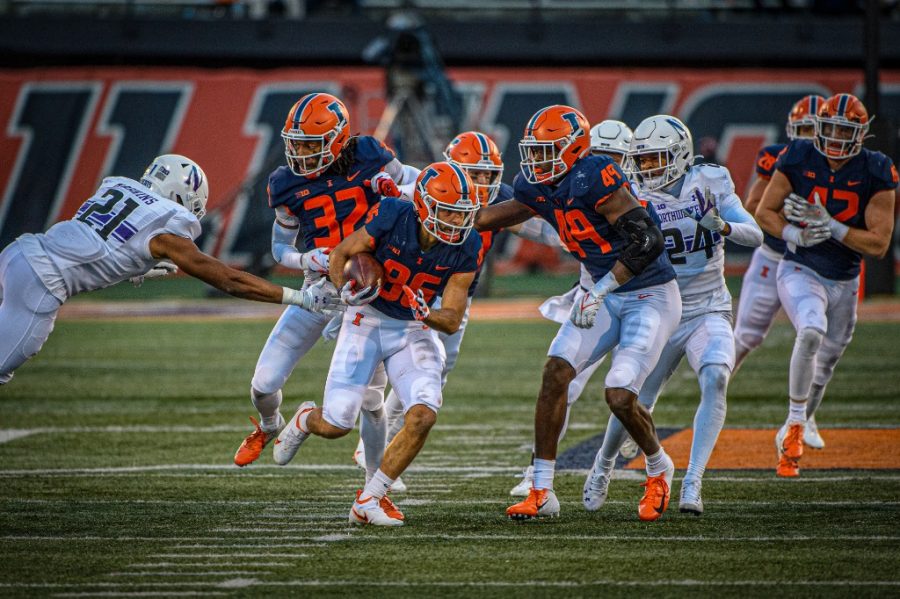Column | Illinois can’t replicate 2021 blueprint for future success
Photo courtesy of Craig Pessman/Illini Athletics
Wide receiver Danny Navarro III (96) takes the ball up the field during the game against Northwestern on Nov. 27. Columnist Carson Gourdie believes that the Illini need a change in structure for next season.
Dec 2, 2021
This was a productive season for Illinois’ football program. With the national consensus being that the Illini would finish dead last in the West division, they finished with four conference wins and showed grit by winning back-to-back road games against ranked teams.
However, college football is incredibly fluid, and an overachieving campaign can easily be undone if followed by a disastrous one. If Bret Bielema wants to recreate the 2021 season in 2022 and make no adjustments, he risks the possibility of losing all the momentum he’s built so far.
Arguably, the best games Illinois played were against Penn State and Minnesota. But let’s look at some facts. Penn State quarterback Sean Clifford wasn’t healthy. Illinois had a veteran offensive line that created massive holes for running back Chase Brown. Penn State had just suffered an emotional loss to Iowa and may have been looking ahead to Ohio State the next week.
Next year, Illinois has to travel to Penn State again. This time though, Illinois can’t count on Penn State’s quarterback to be injured. Illinois is replacing four offensive lineman next season, which means running for 350-plus yards won’t be as likely.
The Illini defense wasn’t supposed to be good this season, but Ryan Walters turned the tide and dramatically improved the product on the field. Next season, I expect more of the same. If he was able to shut down offenses with Lovie Smith players who gave up 40 points regularly, I’m assured he can find transfer portal talent to fill in the gaps.
Get The Daily Illini in your inbox!
But even when the defense performed well — like against Maryland, Purdue and Rutgers — their efforts fell short because of the offense. What gives Illinois any hope that the offense will be dramatically better next season?
Tony Petersen was bad this season. Very bad. We can argue whether he had the correct personnel that he needs to succeed, but I question more of his play calls that have little to do with personnel. Why did he call a draw play with no timeouts and less than a minute left against UTSA? Why did he only have Peters throw nine passes against Minnesota? Why did he prefer Casey Washington and Caleb Griffin to throw wide receiver passes instead of Isaiah Williams? Why did he choose to run a pitch play with no blockers on fourth-and-1 against Rutgers?
We can applaud the defense, but next season, Minnesota’s offense will be more lethal with the return of injured All-Big Ten running backs. Penn State likely won’t have an injured quarterback. Nebraska will have a new offensive vision with new coordinators. Michigan State is on the schedule next season, which averaged over 31.9 points per game. Illinois has to travel to Michigan, a probable national title contender, next season.
Next season, Illinois has to replace four offensive linemen and Daniel Barker, they still have Petersen and a lack of playmaking talent at the wide receiver position. To say that the transfer portal is important is an understatement. Given those problems with the Illini offense, though, what quarterback in their right mind would transfer to Illinois? Trying to run smashmouth football with a gutted offensive line and a lack of playmaking receivers doesn’t scream 30 points per game.
I truly loved watching the team outperform against top competition this season, but I think deep down the Illini caught a lot of breaks. Nobody is expecting Bielema to win a conference title any time soon, but next season could be a huge setback record-wise. If Petersen shows no faith in his quarterback and the Illini try to just “pound” Big Ten teams, they will run into a brick wall with its inexperienced offensive line.
The Illini need to take chances next season and get creative on the offensive side of the football. A setback to 2-10 or 3-9 will set the program back for a while as Bielema won’t be able to advertise a quick return of quality football in Champaign.
@GourdieReport






